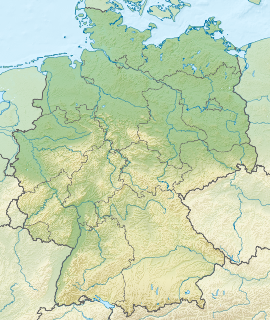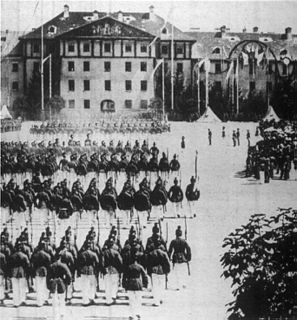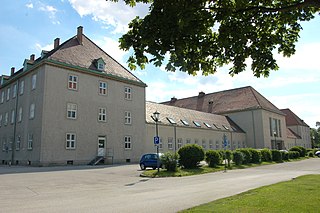
Coleman Kaserne was a United States Army base located in the German city of Gelnhausen, located in the state of Hessen. Coleman Kaserne should not be confused with the U.S. Army "Coleman Barracks" which is located in Mannheim. Kaserne is a German word for barracks.

Fredericia municipality is a municipality on the east coast of the Jutland peninsula in south-central Denmark. It belongs to Region of Southern Denmark, covers an area of 134.46 km2, and has a total population of 49,463 (2008). The Mayor is Jacob Bjerregaard, representing the Social Democrats political party.

Laxenburg castles are imperial palaces and castles outside Vienna, in the town of Laxenburg owned in equal parts by Vienna and Lower Austria. The castles became a Habsburg possession in 1333 and formerly served as a summer retreat, along with Schönbrunn palace, for the imperial Habsburg dynasty. Blauer Hof Palace was the birthplace of some members of the royal family, including Crown Prince Rudolf. Another castle nearby is named Franzensburg castle.

Patch Barracks is a U.S. military installation in Stuttgart, Germany. It is named after U.S. Army General Alexander M. Patch (1889–1945).

Kelley Barracks is a U.S. military installation and headquarters of United States Africa Command, and is a part of US Army Garrison Stuttgart in Stuttgart-Möhringen in Germany. The post is administered by IMCOM- Europe.

Rudolf barracks is historic army barracks site in Zagreb, Croatia, today serving for various public purposes.

The Maximilian-II-Kaserne respectively Max-II-Kaserne was a military facility in Munich, Germany, which was completed in 1865. The kaserne was named after Maximilian II of Bavaria.

The Ernst-von-Bergmann-Kaserne, before called Warner Kaserne by the US Army (1950-1968), has been a military facility in Munich, Germany, which was built by the architect Oswald Bieber between 1934 and 1936. The current name was given in honor of professor Ernst von Bergmann.
Fürst-Wrede-Kaserne has been a military facility in Munich, Germany, since 1936 when it was built by the Munich Heeresbauamt under its original name Verdun-Kaserne. After World War II the U.S. forces renamed it Will Kaserne, and the Bundeswehr renamed it once more in honor of Karl Philipp von Wrede on 17 April 1972.
The Bayern-Kaserne is a military facility in Munich, Germany, originally named General-Wever-Kaserne. The facility was constructed between 1936 and 1938. After World War II it was renamed by the United States forces to Henry Kaserne in honor of Private Robert T. Henry. When it was transferred to the German Bundeswehr, it was renamed once more in honor of General Walther Wever on 9 October 1969.
The Luitpoldkaserne, originally Luftschifferkaserne, was a kaserne at Infanteriestraße 19 in Munich, Germany, which was built after 1896 to accommodate the air skippers unit of the Bavarian army, which was disposed in 1890.

The Hofgartenkaserne, also known as Infanterie-Leibregiment-Kaserne or Max-Joseph-Kaserne, was a military facility of the Bavarian army, located at Hofgarten Strasse 2 in Munich, Germany. The construction was planned and realized by the war economy councillor Direktorialrat Joseph Frey from 1801 to 1807.

The Seidenhauskaserne, also called Artillerie-Kaserne, was a small military facility of the Bavarian army, located at Hofgarten Strasse 1 in Munich, Germany, which existed from 1808 until 1899.

The Türkenkaserne was a Bavarian Army barracks in the Maxvorstadt district of the German city of Munich.
Robinson Barracks is a military base of U.S. in the Burgholzhof community in the northern Stuttgart district of Bad Cannstatt. Unlike Patch Barracks and Kelley Barracks, also located in Stuttgart, the modern Robinson Barracks is now largely a residential neighborhood for US Department of Defense personnel stationed in the greater Stuttgart area operated and administered by IMCOM- Europe. The installation is named after 1st Lt. James E. Robinson, Jr. (1918–1945), an Army officer posthumously awarded the Medal of Honor during World War II.

Panzer Kaserne is a U.S. military installation in Böblingen, Germany, part of U.S. Army Garrison Stuttgart. The post is administered by U.S. Army Installation Management Command-Europe (IMCOM-Europe), a legacy from its use as an Army installation since just after World War II. Panzer also hosts the headquarters of U.S. Marine Corps Forces, Europe & Africa (MARFOREURAF) and various Special Operations units of the Army and Navy supporting EUCOM and AFRICOM.

Østerfælled Barracks, later known as Østerbrogade Kaserne, was a barracks originally built in the 1890s for the Guard Hussars of the Royal Danish Army in the emerging Østerbro district of Copenhagen, Denmark. Its grounds have now been transformed into a mixed-use development surrounding a pedestrian zone and is now known as Østerfælled Torv. Many of the old buildings have been retained while others have been demolished to make way for new residential buildings. The old main entrance to the barracks is located on the corner of Østerbrogade and Gunner Nu Hansens Plads.

Wallace Barracks is a former German and U.S. Army installation in the Bad Cannstatt district of Stuttgart, Germany. It is located just below the Burgholzhof, near Robinson Barracks and the former Grenadier Kaserne on the site of a former Roman military camp commonly referred to in literature as Kastell Cannstatt.

Daun Barracks in Wiener Neustadt in Lower Austria was built by the German Wehrmacht from 1939 to 1940 as a course building in the Academy Park south of the castle.

The Augartenbrücke is a bridge that crosses the Donaukanal in Vienna, which connects the 9th district (Alsergrund) and the 1st district on the southwest side of the canal with the 2nd district, Leopoldstadt, on the northeast side. There has been a bridge on the site since 1782.















